The Best of Friends, the Best of Collaborators—Degas/Cassatt at the National Gallery of Art, Washington, DC

“Little Girl in Blue Armchair,” 1878, by Mary Cassatt
The most satisfying art shows—and this is one of them—pair beautiful, challenging, or even disturbing art with informative behind-the-scenes information, be it historical, technical, personal, or in this case, all three. Close friends for nearly 40 years, Mary Cassatt said that knowing Edgar Degas had “changed my life,” while Degas, upon first seeing Cassatt’s work, said, “…there is someone who feels as I do.” The rich material accompanying this show brings that long relationship—and the work it spawned—to life.
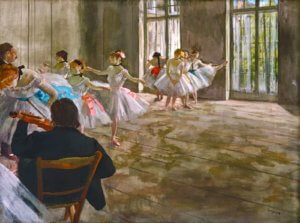
“Rehearsal in the Studio,” 1878-79, by Edgar Degas
Room one, “Experimentation and Exhibition,” looks at both artists’ use of unusual materials: distemper (pigment mixed with glue), metallic paint, and egg tempera, and the bold choices in paintings they hung in the 1879 Impressionist Exhibition, a breakthrough show for Cassatt and a huge success for Degas.
A long-time favorite by Cassatt (National Gallery of Art), “Little Girl in Blue Armchair,” oil on canvas, 1878, was Cassatt’s first truly Impressionist painting. I love the rapid, slapdash brush-strokes of the chintz, the caught-in-time moment, as if the child has thrown herself down for a moment of deep childhood contemplation, or has just awakened from a nap. As on an endless Saturday afternoon, time seems to expand into the room. Turns out Degas may have had something to do with that. On his advice, Cassatt changed the horizontal line where the wall meets the floor to a more dynamic triangular corner. This necessitated shifting the furniture around and moving the dog—originally on the floor behind the child—to the chair opposite. This change produces a companionable symmetry between child and dog, and further opens up the space.

“Mary Cassatt at the Louvre: the Etruscan Gallery,” 1878-80, by Edgar Degas
Shown at the 1879 Impressionist Exhibition, Degas’ “Rehearsal in the Studio,” egg tempera on canvas (collection of the Shelburne Museum, Vermont), 1878-79, shows his fascination with and influence by Japanese composition: the low perspective, blocks of color, and subdued palette.
Room Two is called “Le Jour et La Nuit,” which refers to a journal of experimental prints that Cassatt and Degas were to publish together, again experimenting with an unfamiliar technique of soft ground etching. Again, as in Japanese art, the two embraced imperfections and accidents as they emerged. The charming “Woman Seated in the Loge,” by Mary Cassatt, ca. 1880 (a lithograph now at the Museum of fine Arts, Boston), seems at first to be a sketch, its free and open lines appearing to have been dashed off right there in the theater. Also owned by the MFA, Boston, Degas’ crayon lithograph “At the Theater: Woman with a Fan,” has the same vivid on-the-spot quality and again shows Japanese influence in the composition. Neither image is available, sadly.

“Mary Cassatt,” 1879-84, by Edgar Degas
The room, “Mary Cassatt at the Louvre” gives us a multi-faceted view of the artist as Degas saw her. Demanding, curious, elegant in her person, Cassatt comes to life here.
“Mary Cassatt at the Louvre, the Etruscan Collection,” 1879-80 (soft ground etching, drypoint, aquatint, and etching) is highly detailed and technically accomplished. An entire wall is devoted to this subject, and in viewing the various prints, sketches, oils and pastels, you sense that you’ve really seen the Mary Cassatt Degas so admired, as she moves with assurance through the Louvre’s many galleries.
“Mary Cassatt,” 1876-84, oil on canvas (National Portrait Gallery), is a penetrating portrait, one that Cassatt hung in her studio for years, but eventually tired of, and sold quietly without Degas’ knowledge. It’s not conventionally pretty, not by a long shot, but this woman looks like someone I’d like to know. I was jarred out of my communion with Cassatt by a pair of young women who approached the painting, one saying, “She looks mean.” To which the other replied, “She’s just like, you know, ‘I can’t be a part of any more of this crap.’” Well, maybe. I’ve heard that Degas was pretty hard to get along with.

“Fan Mount-Ballet Girls,” 1879, by Edgar Degas
In the next room, “Collecting and Exchanging,” we learn that Degas collected Cassatt’s many images of the same print, indicating that he loved not only the finished product, but her process in making them. For her part, Cassatt preferred to set up sales for artist friends with wealthy Americans, but owned six of Degas’ works, small, intimate pieces such as “Fan Mount—Ballet Girls,” 1879, watercolor and gold on silk (Metropolitan Museum of Art). Part of a trade, Cassatt said this work was “…the most beautiful Edgar Degas every painted.”
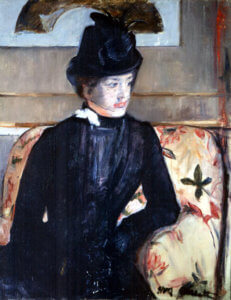
“Young Woman in Black (Portrait of Madame J),” 1883, by Mary Cassatt
In the luscious, “Young Woman in Black (Portrait of Madame J),” 1883, oil on canvas (Maryland State Archives), Cassatt pays sly homage to her friend by posing her model in front of Degas’ fan mount.
The final room, “Beyond 1886,” explores a turning point in both the artists’ friendship and their careers. While they remained steadfast lifelong friends, the intense collaboration of their earlier years waned, with Cassatt devoting more and more time to her paintings of mothers and children. Her works became more realistic and less impressionistic—and, let’s face it, more treacley—while Degas’ work took the opposite turn.

“Forest in the Mountains,” 1890, by Edgar Degas
The brooding “Forest in the Mountains,” a Degas monotype (Museum of Modern Art), 1890, is a startlingly abstract vision, with its smear of dark red paint like dried blood, and the looming tree hinting at the hidden power of nature.
Both Degas’ and Cassatt’s love of Japanese prints endured during this period and their influence can be seen in another favorite Cassatt image, “Woman Bathing,” 1890-91, a color drypoint and aquatint (National Gallery of Art).
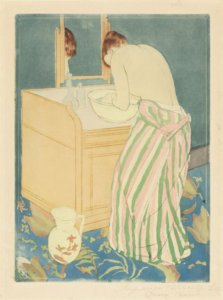
“Woman Bathing,” 1890-91, by Mary Cassatt
If this sampling has whetted your appetite for more, “Degas/Cassatt,” with around 70 works on view, is up until October 5, 2014.
http://www.nga.gov/content/ngaweb/exhibitions/2014/degas-cassatt.html

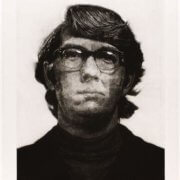
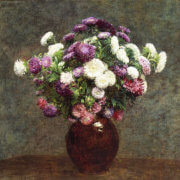
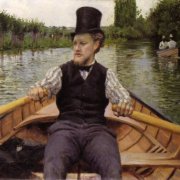


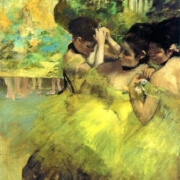
Leave a Reply
Want to join the discussion?Feel free to contribute!